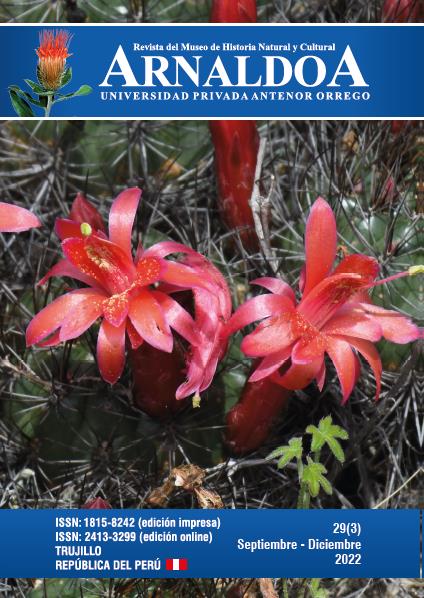Preliminary study of the natural diversity of the Huasochugo Archaeological Site, Huaso district, Julcán province, La Libertad region, Peru
DOI:
https://doi.org/10.22497/1684Keywords:
Huasochugo hill, Endemism, Puya raimondii, ethnobotany, Julcán, western slope, Amotape-HuancabambaAbstract
The Huasochugo archaeological center extends over 5 km2, on the crest of three ledges and plains of the hill of the same name, on the left bank of the La Vega river, Shulgán hamlet, Huaso district, Julcán province, La Libertad region, Peru (3,739 masl and 8°16'15.03''S 78°27'55.03''W). It presents cultural (extension, edged stone architecture and planning) and natural importance. The preliminary study of flora and fauna is disclosed. The Flora presents 69 species, 56 genera and 30 families. Two fern families, one gymnosperm family (Ephedraceae) and 27 angiosperm families (24 families are dicots and three are monocots). Asteraceae registers the largest number of species (16 sps.; 23.19%). 16 species are endemic. Lupinus otuzcoensis C.P. Sm. (Fabaceae), Quinchamalium elongatum Pilg. (Schoepfiaceae) and Jaltomata mionei S. Leiva & Quip. (Solanaceae) are Endangered (EN). The main biotype is Puya raimondii Harms (Bromeliaceae) “cahuaâ€. Knowledge about the use of plants, in various activities of daily life, has been transmitted over time. For the fauna, two endemic species of lizards (Stenocercus latebrosus Cadle, 1998, and Stenocercus melanopygus Boulenger, 1900) and 12 species of birds listed as Least Concern (LC) were recorded.Downloads
Download data is not yet available.
Downloads
Published
2023-02-13
Issue
Section
Artículos originales
License
By submitting a paper to the journal, it is understood that the authors agree to transfer the publication rights to the journal once it is accepted.
It is permitted to share and adapt the contents of this journal in any medium or format always if the original source is properly cited and there are not commercial purposes.







